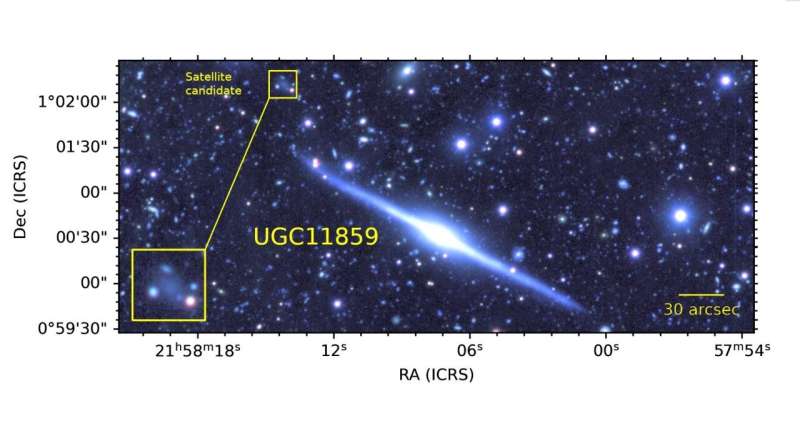July 26, 2023 report
This article has been reviewed according to Science X's editorial process and policies. Editors have highlighted the following attributes while ensuring the content's credibility:
fact-checked
peer-reviewed publication
trusted source
proofread
Study inspects the ultra-thin galaxy UGC 11859

Using the Gran Telescopio Canarias (GTC), astronomers have performed optical imaging observations of an isolated ultra-thin galaxy known as UGC 11859. Results of the observational campaign, published July 12 in The Astrophysical Journal, deliver important insights about the structure and properties of this galaxy.
Located some 167.5 million light years away, UGC 11859 is a relatively isolated edge-on ultra-thin galaxy. Although the galaxy is isolated, it showcases a relatively high asymmetry index in the neutral atomic hydrogen (HI) profile, which points to possible invisible interactions with the medium at low surface brightness.
Edge-on isolated galaxies like UGC 11859, due to their projected orientation, are excellent targets to study the three-dimensional structures of galaxies including warps and flares, and to investigate possible sources of such distortions. That is why a team of astronomers led by Luis Ossa-Fuentes of the University of Valparaíso in Chile, decided to observe UGC 11859 with GTC's OSIRIS camera in order to search for distortions.
"The observations were made using the OSIRIS camera with SDSS g and r wavelength filters in order to maximize the transmission of the atmosphere and filter system. The field of view was sufficient to simultaneously map the stellar disk and its potential low surface brightness external structures," the researchers explained.
The observations found that the disk of UGC 11859 exhibits a significant gravitational distortion. The images, both in g and r bands, show the presence of a warp at one side of the stellar disk. The warp appears at a radius where the surface brightness has fallen to low values.
The galactic plane on both sides of the center of UGC 11859 displays increasing scale height with increasing galactocentric radius, which suggests the presence of a flare in the stellar distribution. Moreover, the radial surface brightness profile of the disk showcases a clear break and a sharp fall at a galactocentric radius of about 78,000 light years, indicating an edge-on truncation.
The astronomers noted that the existence of a warp and a flare in the outer disk of UGC 11859, coincidentally with a break in the surface brightness profile, poses the question of whether the phenomena could be related.
"The presence of this flare supports the suggestion that edge-on disk truncations can be produced by the combination of a flare with the down-bending profile of a conventional Type II disk," the authors of the paper concluded.
The study also detected a possible small satellite galaxy beyond the warped side of UGC 11859's disk within a small angular distance. This faint satellite received designation GTC-1 and its associations with UGC 11859 need to be confirmed by spectroscopic observations.
More information: Luis Ossa-Fuentes et al, Flares, Warps, Truncations, and Satellite: The Ultra-thin Galaxy UGC 11859, The Astrophysical Journal (2023). DOI: 10.3847/1538-4357/acd54c
Journal information: Astrophysical Journal
© 2023 Science X Network




















